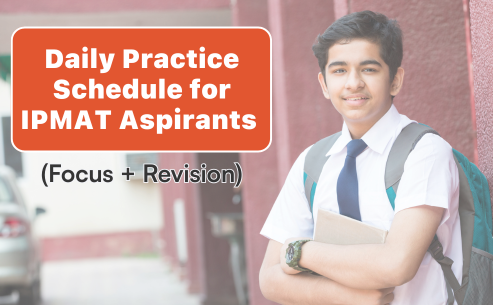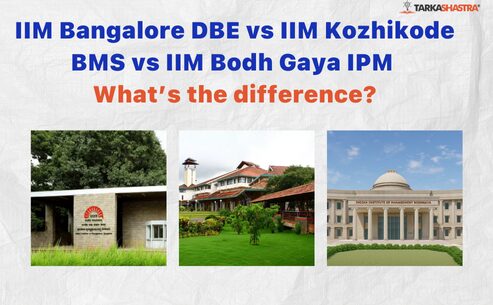The IPMAT Rohtak 2026 (Integrated Programme in Management Aptitude Test) is the entrance exam conducted by IIM Rohtak for admission to its prestigious 5-Year Integrated Programme in Management (IPM). It offers a unique opportunity for students to secure a direct path into one of India’s top IIMs right after Class 12.
But cracking IPMAT Rohtak isn’t just about solving questions — it’s about solving the right questions. That starts with knowing the syllabus inside out.
Why is the syllabus critical?
Because in a competitive exam like IPMAT Rohtak, clarity of scope is half the preparation done.
The exam consists of three sections:
- Quantitative Ability (QA)
- Logical Reasoning (LR)
- Verbal Ability (VA)
Each section tests a distinct skill set — from numerical aptitude and analytical thinking to language comprehension — through multiple-choice questions (MCQs).
In this blog, we’ll provide you with a section-wise breakdown of the IPMAT Rohtak 2026 syllabus, including:
- Complete list of important topics and subtopics
- Estimated weightage and difficulty level
- Preparation tips tailored to each section
- FAQs and downloadable PDF
Whether you’re just starting out or restructuring your prep, this guide will help you align your efforts with what actually matters.
Let’s begin with understanding the exam pattern before breaking down each section in detail.
IPMAT Rohtak 2026: Exam Pattern Overview
Before diving into the syllabus, it’s essential to understand the structure of the IPMAT Rohtak 2026 exam. Unlike IIM Indore’s pattern, which includes a Short Answer (SA) section, the IPMAT
Rohtak exam is entirely MCQ-based, making it more uniform in format and time management.
The test assesses three core areas:
- Quantitative Ability (QA)
- Logical Reasoning (LR)
- Verbal Ability (VA)
Each section is designed to evaluate a specific skill set, with equal weightage given to all three.
IPMAT Rohtak 2026 Exam Structure
| Section | No. of Questions | Time Limit | Type of Questions | Marking Scheme |
| Quantitative Ability | 40 | 40 minutes | Multiple Choice Questions | +4 for correct, -1 for incorrect |
| Logical Reasoning | 40 | 40 minutes | Multiple Choice Questions | +4 for correct, -1 for incorrect |
| Verbal Ability | 40 | 40 minutes | Multiple Choice Questions | +4 for correct, -1 for incorrect |
| Total | 120 | 120 minutes |
Key Highlights:
- The exam has no sectional switching. Once a section starts, you must complete it within the allotted time.
- All questions are objective type (MCQs), with four options each.
- There is a negative marking of -1 for every incorrect answer.
- The test is conducted online, typically at designated test centres across India.
Tip: An equal number of questions doesn’t mean equal preparation time. Quant often takes longer to master—plan accordingly.
With the exam format now clear, let’s break down the syllabus section by section, starting with Quantitative Ability.
Quantitative Ability (QA)
The Quantitative Ability section of IPMAT Rohtak 2026 is designed to assess a candidate’s numerical aptitude, mathematical reasoning, and calculation accuracy. With 40 MCQs to be solved in 40 minutes, the section requires both speed and conceptual clarity.
Unlike board exams that reward stepwise solving, IPMAT expects you to cut through problems efficiently — often under pressure. So, knowing which topics matter can save both time and effort.
Topics Covered in Quantitative Ability
| Topic | Key Concepts/Subtopics |
| Number System | LCM & HCF, divisibility rules, remainders, base systems, cyclicity |
| Arithmetic | Percentages, Profit & Loss, Simple & Compound Interest, Ratio & Proportion |
| Averages & Mixtures | Weighted averages, Alligation rule |
| Algebra | Linear & Quadratic Equations, Algebraic Identities, Inequalities |
| Geometry & Mensuration | Triangles, Circles, Polygons, Areas, Volumes, 2D/3D Geometry |
| Time, Speed & Distance | Relative speed, Boats & Streams, Trains |
| Time & Work | Work-Efficiency, Pipes & Cisterns |
| Data Interpretation | Tables, Bar Graphs, Line Graphs, Pie Charts (Basic DI problems) |
| Permutation & Combination | Factorials, Counting Principles, Basic Arrangements |
| Probability | Simple events, coin/dice problems, card-based scenarios |
| Set Theory | Venn Diagrams, Union-Intersection |
| Sequences & Series | Arithmetic Progression (AP), Geometric Progression (GP), Sum of n terms |
| Logarithms & Indices | Laws of Logs, Simplification, Surds & Indices |
Key Preparation Tips
- Foundation first: Build concepts using NCERT Class 9–11 books before jumping into advanced material.
- Mock practice: Take topic-wise timed quizzes to build speed.
- Shortcuts matter: Learn tricks for percentages, ratios, and averages to save time during calculation.
- DI is scoring: Practice reading data charts quickly and accurately.
Estimated Topic-Wise Weightage (Past Trends)
| Topic | Number of Questions |
| Venn Diagram | 2 |
| Boats & Streams | 2 |
| Train | 1 |
| Simple Interest / Compound Interest | 4 |
| Percentages | 2–3 |
| Profit & Loss | 1–2 |
| Mixture & Allegations | 1–2 |
| Ratio | 1–2 |
| Ages | 1 |
| Permutation & Combination, Probability | 2 |
| Geometry & Mensuration | 3 |
| Pipe & Cistern | 1 |
| Basic Algebra | 1–2 |
| Calendar | 1 |
| Coordinate Geometry | 2 |
| Number System | 1 |
| Average | 2–3 |
Note: The exact number of questions may vary each year, but the distribution gives you a strategic prep direction.
Logical Reasoning (LR)
The Logical Reasoning section in IPMAT Rohtak 2026 evaluates a candidate’s analytical ability, decision-making skills, and pattern recognition. It consists of 40 MCQs to be attempted in 40 minutes, making it a high-speed, high-focus section.
Unlike Quant, LR doesn’t rely on formulas — instead, it rewards structured thinking and mental agility. Regular practice is the only way to master this section.
Topics Covered in Logical Reasoning
| Topic | Key Concepts / Subtypes |
| Series & Patterns | Number series, alphabet series, odd-one-out, pattern continuation |
| Coding-Decoding | Letter coding, symbol coding, numerical coding |
| Blood Relations | Puzzle-based and direct relation-based questions |
| Direction Sense | Compass-based logic, distance/direction determination |
| Syllogisms | Venn diagram method, analytical conclusions |
| Seating Arrangements | Linear and circular arrangements, with or without conditions |
| Puzzles | Family trees, comparisons, sequencing problems |
| Data Sufficiency | One-statement/two-statement sufficiency for decision-making |
| Logical Deductions | Statement-conclusion, statement-assumption, cause-effect |
| Input-Output | Machine-based reasoning questions (rare but asked occasionally) |
| Clocks & Calendars | Basic formula-based time and date logic |
| Ranking & Order | Position-based logic, age ranking, tallest-shortest type questions |
Key Preparation Tips
- Start with the basics: Strengthen the fundamentals of patterns, puzzles, and sequences.
- Practice daily: 2–3 LR sets a day can significantly boost accuracy and familiarity.
- Visual aids: Use tables, flowcharts, and diagrams to decode seating, puzzles, and family trees.
- Avoid assumptions: Stick to what’s given — Logical Reasoning is about inference, not intuition.
Estimated Topic-Wise Weightage (Past Trends)
| Topic | Number of Questions |
| Direction Test | 3 |
| Coding-Decoding | 3 |
| Circular Sitting Arrangement | 5 |
| Linear Arrangement | 2 |
| Number Series | 1 |
| Blood Relation | 1 |
| Cube | 1 |
| Dice | 1 |
| Critical Reasoning (CR) | 2 |
| Data Sufficiency | 2 |
| Comparison-Based Arrangement | 2 |
Tip: LR is highly scoring once you crack the pattern — invest time early to reap the rewards later.
Verbal Ability (VA)
The Verbal Ability section of IPMAT Rohtak 2026 tests your English language comprehension, grammar accuracy, vocabulary depth, and logical structuring of ideas. With 40 MCQs to be solved in 40 minutes, this section can be a strong scoring area — provided you have a habit of reading and a grasp of the rules.
This section does not involve heavy memorization but focuses on your ability to understand, interpret, and apply language logically.
Topics Covered in Verbal Ability
| Topic | Key Concepts / Subtypes |
| Reading Comprehension | Inference-based, factual, tone & theme questions, vocabulary in context |
| Para Jumbles | Sentence rearrangement for logical flow |
| Sentence Completion | Fill-in-the-blanks using contextual clues and vocabulary |
| Sentence Correction | Grammar-based MCQs testing usage, subject-verb agreement, modifiers |
| Error Spotting | Identifying incorrect segments in a sentence |
| Vocabulary | Synonyms, antonyms, one-word substitutions, confusing words |
| Idioms & Phrases | Common expressions and their contextual usage |
| Analogies | Word-pair relationships based on function, classification, or degree |
| Cloze Test (Occasional) | Paragraph with blanks testing grammar and flow |
Key Preparation Tips
- Read daily: Newspaper editorials, fiction/non-fiction, and opinion pieces improve comprehension.
- Revise grammar rules: Focus on subject-verb agreement, modifiers, and prepositions.
- Build vocabulary in context: Rather than rote memorization, learn words through usage.
- Solve past RCs: Regular practice will help improve accuracy and time per passage.
Estimated Topic-Wise Weightage (Past Trends)
| Topic | Number of Questions |
| Reading Comprehension (4 sets) | 10 |
| – Full-Length RC (2 passages) | 3 |
| – Poem-Based RC | 2 |
| – Short RC (1 passage) | 2 |
| Vocabulary | 8–10 |
| – Spelling Error | 2 |
| – Synonyms | 1 |
| – Antonyms | 1 |
| – Idioms | 2 |
| – Fillers | 2 |
| – Odd Man Out | 2 |
| Grammar | 8 |
| – Active/Passive Voice | 2 |
| – Conjunctions | 2 |
| – Subject-Verb Agreement | 3 |
| – Phrasal Verbs | 0 |
| – Prepositions | 1 |
| Para Jumbles | 2 |
| Odd Sentence Out | 2 |
RCs are generally medium in length and moderate in complexity. Efficient reading and inference are key.
Syllabus Difficulty Level
Understanding the topic-wise weightage and difficulty level in IPMAT Rohtak 2026 is essential to prioritising your preparation. While the exam gives equal number of questions to all three sections (40 each), the preparation effort is not necessarily equal—some topics demand more time and conceptual clarity.
Below is a detailed breakdown of past trends to help you align your prep strategy better.
Section-Wise Overview
| Section | No. of Questions | Time Allotted | Difficulty Level | Remarks |
| Quantitative Ability | 40 | 40 minutes | Moderate to Difficult | Concept-heavy; questions often time-consuming |
| Logical Reasoning | 40 | 40 minutes | Easy to Moderate | High scoring if patterns are mastered early |
| Verbal Ability | 40 | 40 minutes | Easy to Moderate | Focuses on grammar, RCs, and vocab — manageable with reading habit |
| Total | 120 | 120 minutes | — | All sections are time-locked; no switching allowed |
Difficulty Trends (Last 2–3 Years)
| Section | Trend | Student Perception |
| Quantitative Ability | Moderate to Tough | Calculation-heavy, conceptual clarity needed |
| Logical Reasoning | Easy to Moderate | Patterns get predictable with enough practice |
| Verbal Ability | Easy to Moderate | RC and grammar dominate; vocab manageable |
Conclusion: Invest more time in Quant to strengthen fundamentals. Use LR & VA to maximize your score with consistent practice.
How IPMAT Rohtak Syllabus Differs from Other BBA Entrance Exams
Many aspirants prepare for multiple BBA entrance exams simultaneously — such as NPAT (NMIMS), SET (Symbiosis), CUET (for DU/JMI/BHU), and Christ University ET. While the overall preparation themes may seem similar, IPMAT Rohtak stands apart in structure, content focus, and difficulty level.
Here’s how IPMAT Rohtak’s syllabus compares with other leading exams:
Syllabus & Exam Structure Comparison
| Parameter | IPMAT Rohtak | Other BBA Exams (NPAT, SET, CUET, etc.) |
| Exam Conducting Body | IIM Rohtak | NMIMS, Symbiosis, NTA, Christ University, etc. |
| Sections | Quant, LR, Verbal (all MCQs) | Quant, LR, Verbal (sometimes GK, WAT, PI) |
| Math Syllabus Level | Up to Class 11 | Mostly Class 10 only |
| Logical Reasoning Focus | Moderate puzzles, arrangements, deductions | More focus on series, analogies, and general reasoning |
| Verbal Section Style | Grammar + Reading Comprehension heavy | More vocabulary-based; fewer RCs |
| Question Format | All MCQs, 120 questions in total | Mostly MCQs; total questions vary widely |
| Difficulty Level | Moderate | Easy to Moderate |
| Negative Marking | Yes (-1 for incorrect) | Varies (NPAT/SET have no negative marking) |
| Short Answer Questions | ❌ Not Included | ❌ Not Included |
| Total Duration | 120 minutes (40 min per section) | 90–120 minutes total (often no sectional timing) |
Key Differences in Preparation Approach
- Quantitative Ability: IPMAT Rohtak requires deeper prep, especially with Class 11 math and topics like Probability, Logs, and Coordinate Geometry.
- Logical Reasoning: While some exams emphasize series/patterns, IPMAT LR includes heavier topics like arrangements, data sufficiency, and critical reasoning.
- Verbal Ability: Unlike vocab-heavy tests like NPAT/SET, IPMAT Rohtak places more weight on Reading Comprehension and Grammar fundamentals.
What This Means for Aspirants
- IPMAT Rohtak is more math- and logic-intensive, demanding stronger conceptual understanding than exams like CUET or SET.
- It is less diverse in structure—there is no GK, essay writing, or personality assessment—making it a better fit for students who prefer pure aptitude-based evaluation.
- A strong IPMAT Rohtak prep strategy will also give you a solid foundation for cracking other BBA exams with minor adjustments.
Tip for Multi-Exam Aspirants: Prep for IPMAT Rohtak first — it’s the toughest of the lot. Once that’s done, adjusting to other BBA exams becomes much easier.
Preparation Strategy Based on the Syllabus
Cracking IPMAT Rohtak 2026 is not just about hard work — it’s about working smart with a syllabus-first approach. With three equally weighted sections but varying difficulty levels, you need to tailor your prep to the nature of each subject.
Let’s explore a practical, section-wise strategy along with resource suggestions and a weekly plan.
Section-Wise Strategy at a Glance
| Section | Focus Area | Approach |
| Quantitative Ability | Speed + Accuracy + Concept Depth | Practice topic-wise questions daily; revise formulas weekly |
| Logical Reasoning | Pattern Recognition & Deduction | Solve 2–3 puzzle sets/day, focus on variety of arrangements |
| Verbal Ability | Grammar + RC + Vocab | Read daily, build vocab in context, practice RC + grammar sets |
Recommended Study Resources
| Subject | Books / Platforms |
| Quantitative Apt. | – NCERT Class 9–11 Maths- R.S. Aggarwal (QA)- Quantitative Aptitude by Arun Sharma |
| Logical Reasoning | – Verbal & Non-Verbal Reasoning by R.S. Aggarwal- Puzzle books by S. Chand |
| Verbal Ability | – Word Power Made Easy by Norman Lewis- Wren & Martin (Grammar)- Editorials (The Hindu / Indian Express) |
| Mock Tests & Mocks | – Previous year IPMAT Rohtak papers- Tarkashastra mocks + analysis tools |
Suggested 12-Week Prep Plan
| Weeks | Quant Focus | LR Focus | Verbal Focus | Mock/Test Plan |
| Weeks 1–4 | Arithmetic, Percentages, Algebra | Series, Directions, Blood Relations | Grammar, Vocabulary, Para Jumbles | 1 sectional test/week |
| Weeks 5–8 | Geometry, DI, P&C, Logs | Arrangements, CR, Data Sufficiency | RCs, Cloze Tests, Sentence Correction | 2 full mocks + 1 section test/week |
| Weeks 9–12 | Revision + High-level Mixed Sets | Mixed Puzzle Sets, Speed Drills | Full-length RC sets + Vocab review | 3 full mocks/week + full reviews |
Preparation Do’s & Don’ts
| ✅ Do This | ❌ Avoid This |
| Create topic-wise checklists and track progress | Blindly solving mocks without post-test analysis |
| Prioritize weak areas in Quant or Grammar | Ignoring Verbal just because it “feels easier” |
| Practice DI/RC with a stopwatch | Spending too long on time-consuming puzzle sets |
| Attempt mocks in actual exam conditions | Taking untimed tests that give a false sense of security |
“The key to cracking IPMAT Rohtak lies in consistency — 90 minutes of focused prep daily beats 6 hours of weekend-only study.”
Common Mistakes Students Make Regarding the Syllabus
Even with a clear understanding of the syllabus, many students still fall into common traps that waste time, hamper improvement and hurt final scores. These mistakes are often small but costly — and knowing them can help you prep smarter than 90% of aspirants.
Top Mistakes and How to Avoid Them
| Mistake | Why It Hurts | What To Do Instead |
| Focusing too much on just Quant | Verbal & LR carry equal weight and are often easier to score | Balance all three sections in your weekly plan |
| Skipping grammar rules and jumping straight to RC | Grammar forms the foundation of 40–50% of VA questions | Learn subject-verb agreement, tenses, modifiers properly |
| Memorizing formulas without application | IPMAT questions are logic-driven, not direct plug-ins | Practice concept-based problem solving and word problems |
| Practicing puzzles but ignoring arrangement-based reasoning | 6–8 questions in LR are based on linear/circular seating | Practice 1–2 complex arrangements every 3 days |
| Not analyzing mocks after taking them | Without review, the same mistakes keep repeating | Spend at least 2x the test time reviewing the mock |
| Leaving DI or RC for the last few weeks | These are time-intensive and improve slowly with consistent practice | Start practicing DI and RC from week 1 in limited sets |
| Studying for Quant only from Class 10 books | Many IPMAT questions require Class 11-level algebra, logs, and coordinate geo | Use NCERT Class 11 + coaching materials for full coverage |
| Depending only on books and skipping timed practice | Speed and decision-making matter more than just knowledge | Use mocks, sectionals, and stopwatch-based drills often |
Bonus Tip: Use a Visual Tracker
Create a simple tracker in your diary or Excel with three columns:
✅ Completed | ⚠️ In Progress | ❌ Yet to Start
Update it weekly. This helps avoid the false sense of “I’ve studied this” and keeps you honest.
“Most students don’t fail due to lack of effort — they fail due to lack of direction.”
Downloadable Syllabus PDF
We get it — you don’t always want to scroll through a long blog while revising. That’s why we’ve created a free, downloadable IPMAT Rohtak 2026 Syllabus PDF that you can print, save, or pin to your study desk.
Compiled by the exam experts at Tarkashastra, this PDF gives you a clear, clutter-free snapshot of everything you need to focus on.
What’s Inside the PDF?
- Full topic-wise syllabus for Quantitative Ability, Logical Reasoning & Verbal Ability
- Section-wise estimated weightage based on previous years
- Key preparation tips for each section
- Ready-to-print format — ideal for tracking revision
- Updated as per the latest IPMAT Rohtak pattern
Download Now
Click here to download the IPMAT Rohtak 2026 Syllabus PDF
Tip: Print it out and highlight each topic as you complete it — small wins lead to significant results.
Conclusion
Cracking the IPMAT Rohtak 2026 isn’t just about solving questions — it’s about solving the right ones with confidence, speed, and clarity. And that begins with a deep understanding of the syllabus.
By now, you’ve seen that:
- The exam includes three equal-weighted sections — QA, LR, and VA — all in MCQ format
- The quant section demands strong fundamentals from Class 9–11
- Logical reasoning rewards pattern recognition and practice, not memory
- Verbal ability is grammar- and comprehension-heavy, not vocab-dominated
- Knowing the topic-wise weightage and trends gives you a significant edge
At Tarkashastra, we believe that a well-structured plan beats hard work done blindly. Our IPMAT mentors and programs are built around helping students like you prepare not just, but with purpose.
“Exams don’t reward how much you know — they reward how well you apply what you know in time.”
Ready to Start Your IPMAT Journey?
Join Tarkashastra’s IPMAT Rohtak 2026 program. From syllabus coverage to mock tests, from shortcuts to strategy — we’ll guide you at every step.
IPMAT Rohtak Syllabus 2026 FAQs
1. What are the sections in IPMAT Rohtak 2026?
The exam has three sections — Quantitative Ability (QA), Logical Reasoning (LR), and Verbal Ability (VA). Each section contains 40 MCQs and is allotted 40 minutes.
2. Is the syllabus for IPMAT Rohtak similar to IPMAT Indore?
Not exactly. IPMAT Rohtak does not have a Short Answer (SA) section and does not include Logical Reasoning, which IPMAT Indore does not. The math level is slightly less advanced than Indore.
3. What is the level of math required for Quantitative Ability?
The syllabus includes topics from Class 9 to Class 11, such as algebra, arithmetic, geometry, DI, and basic probability. Class 12-level math is not required.
4. Is there any negative marking in the exam?
Yes. For each incorrect answer, 1 mark is deducted. Each correct answer gives +4 marks. Unattempted questions carry zero marks.
5. What kind of questions are asked in Logical Reasoning?
Expect questions on arrangements (linear and circular), coding-decoding, series, blood relations, critical reasoning, and direction sense—mostly logic-based, not memory-based.
6. How many Reading Comprehension (RC) passages are there?
Usually, 4 RC sets are asked — including short, medium, and even poem-based passages — and the total number of questions is around 10 in the Verbal Ability section.
7. Is vocabulary essential for IPMAT Rohtak?
Yes. Around 8–10, questions are typically based on synonyms, antonyms, idioms, spelling errors, and one-word substitutions.
8. How should I prepare for Grammar in Verbal Ability?
Focus on core grammar rules like subject-verb agreement, voice, conjunctions, and prepositions. These are tested through sentence correction and error spotting.
9. Are Data Interpretation (DI) questions part of the syllabus?
Yes. DI questions appear under the Quant section in the form of bar graphs, tables, and pie charts and require basic arithmetic for calculations.
10. Is Logical Reasoning complex in IPMAT Rohtak?
Not if you practice regularly. The difficulty is moderate — primarily based on pattern recognition and deduction rather than formulas or memory.
11. Are Class 12 Math topics like calculus or matrices included?
No. The syllabus is limited to Class 11 concepts at most. You don’t need to study calculus, complex numbers, or advanced trigonometry.
12. Is General Knowledge or Current Affairs part of the exam?
No, IPMAT Rohtak 2026 does not include a GK section. The paper is entirely aptitude-based, focusing only on QA, LR, and VA.
13. What is the time management strategy for each section?
You get 40 minutes per section and cannot switch between sections. To adapt to this sectional timing, practice mocks with a stopwatch.
14. How many mocks should I attempt before the exam?
Aim for at least 12–15 full-length mocks. In addition, practice sectional tests and analyze every mock to identify gaps and improve timing.
15. Are calculators allowed in the exam?
No. You are not allowed to use calculators or any electronic devices. All calculations must be done manually using the on-screen rough sheet.
16. Does IPMAT Rohtak include essay writing or WAT?
No, the entrance test does not have a WAT (Written Ability Test) or essay section. However, shortlisted candidates may face a Personal Interview in later rounds.
17. Which topics in Quant have the highest weightage?
Topics like Percentages, Profit & Loss, SI/CI, Time-Speed-Distance, and Algebra consistently appear with higher frequency. DI also carries around 4–5 questions.
18. What should I prioritize if I start late?
Focus first on Arithmetic (Quant), Grammar + RC (Verbal), and basic LR topics like series, directions, and arrangements. These areas cover the bulk of the paper.
19. Can I skip tough topics like Probability or P&C?
While optional, these topics usually contribute 1–2 questions each. It’s better to learn basics and score easy marks rather than leave them altogether.
20. Where can I get the whole syllabus in a downloadable format?
You can download the complete IPMAT Rohtak 2026 Syllabus PDF here, compiled by Tarkashastra. It includes all topics, subtopics, weightage, and prep tips.







